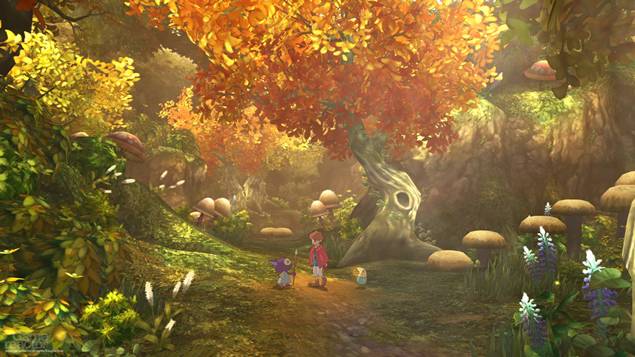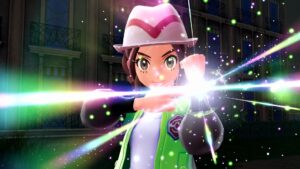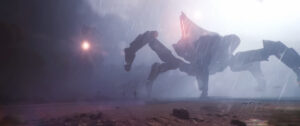
A recurring question entered my mind as I booted up Ni No Kuni: is this the game that will spark the evolution of the JRPG? Or is it a mutated abomination?
Then it grabbed me by the nipples with its arresting visual flair. The game is the end result of a collaboration between Dark Cloud creators, Level 5 and Studio Ghibli, who are basically the Japanese Disney; creating classic anime films such as Spirited Away.
The Japanese animation inspired visual design feels like injecting a rainbow into your retina, or getting slapped by the ocean on a summer’s day.
Vivid strokes of colour dance across the screen as the characters interact animatedly. The animation, in the Ghibli created cutscenes especially, is remarkable. At times, you actually feel as though you’re inside of a Ghibli classic and you feel like a kid again. (Unless you are a kid and then you’ll just feel like you, I suppose, albeit with a happy eyeball).
One of the things I noticed, and I know it doesn’t sound very impressive on paper/the internet, is how the main character actually has a dedicated animation for descending stairs. The JRPG evolution has arrived! I don’t mean to sell it short (I was actually impressed) as this really is a big deal in a genre more interested in stats, than aesthetics and immersion.
Most JRPG’s are focussed on the aforementioned stats and stories. Ni No Kuni is no different – except the story is much more relatable than your standard JRPG fare. Oliver, a boy of thirteen, lives in small-town America, called Motorville, complete with white picket fences and OCD afflicted gardeners.
The story starts out with its feet firmly planted in the realms of reality and promptly burrowing deeper into the rabbit-hole.
After a traumatic experience in the ‘real world’, Oliver is promptly whisked off to a parallel version of his reality by his stuffed toy, Drippy, who came to life after being activated by the tears of the crying boy.
Drippy claims to be Lord, High Lord of the fairies, in a land called Ni No Kuni, where Oliver may be able to fix the cause of his recent trauma. in the process stopping the evil Shaddar, who is stealing portions of peoples’ hearts.
There are hints throughout, that the fantasy world you’re spirited to, is just that… a fantasy. The experiences faced by the young Oliver, are enough to make anyone retreat into a fabrication in the recesses of their mind. It’s always hinted, but never explicitly stated, making for a more interesting and involving narrative for an inquisitive mind.
The alternate dimension is filled with doppelgangers of the people Oliver knows back in his hometown, and even some of the animals. Also, when he is inside Motorville (as you travel between worlds to overcome certain problems) nobody acknowledges his otherworldy companions.
If Ni No Kuni is a construct of Oliver’s mind, he must have the disposition of an artist.
When you enter the exceptional environment for the first time, you are greeted with vast expanses of green fields and blue skies. Birds fly past, clouds roll across the sky, tracing shadows along the ground beneath your feet. Little traces of light flash across the sky, and the grass sways in the wind. It is the most detailed ‘world map’ I’ve seen in the genre.
It isn’t long after you first enter this lush landscape until you encounter an enemy, who are all visible, and avoidable, in the field. These play out in real time, allowing you free movement on the battlefield so you can make space between yourself and the enemy, evading attacks and setting up abilities. It starts off simply and drip feeds mechanics, sometimes during boss battles, infuriatingly.
As your quest develops, you gain access to a myriad of friendly creatures called Familiars. Each has a specific combat role and gains in experience alongside the antagonist as the game progresses.
As they ‘level up’, they gain access to new skills and can eventually be forced into evolving by feeding them a specific item. When you evolve the creatures it resets their ‘level’ to one, but once they reach the point they were at originally, they will be much more powerful versions of themselves.
In battle, you can only control Oliver or one Familiar/ally at a time. Each Familiar has a timer that ticks down until they eventually pass out from overexertion. This is a means of encouraging you to use your whole arsenal, but is a mixed success. In most of the big battles, you can get through it by running from your enemy as Oliver and firing off spells when they inevitably miss a strike.
As long as you can time your use of the defense command and can top up your MP when it’s low, you can win the majority of the bigger encounters with this tactic. That’s not to say it works on them all, however. In fact, some of the encounters are controller-snappingly infuriating.
The difficulty just sort of ambles along at a steady rate, spikes suddenly and then dips again, dramatically. The frustration only increases in tandem with the number of companions and usable abilities at your disposal.
When it does work though, the battle system feels fresh and hands-on; the free movement adding a layer of involvement into proceedings, especially as you need to keep an eye out for restorative Glims. Glims come in three flavours: blue for magic, green for health and gold to unleash a powerful, character specific ability.
Seeing all the different Familiars’ Miracle Moves (as the Golden Glim attacks are called) is compulsive gaming at its best, and collecting the perfect team of miniature critters is as addicting as it was when a certain game popularised the concept.
You capture them by beating their asses until they love you, and then using one of your allies’ skills to serenade them.
Each Familiar has a star sign and creature type. Each human character has preferred familiar types, and after it’s explained to you, it’s down to you to find the miniature icons representing preferences.
This is the point where I find the game slightly inconsistent: things that should be simple, are sometimes vague, yet the things that could be used to add a layer of thought to the exploration are overly simplified.
As you progress through Ni No Kuni, you meet people who have had their hearts broken by Shaddar, and it’s up to Oliver to fix them. You do this by finding out what it is they’re missing and then finding somebody with an excess of the trait they are lacking.
How do you find what they are lacking/overflowing in, I hear you ask? You find out because the game tells you exactly what you have to do, taking any thought out of the process.
Even when you know what you must do, you can’t pull up the magic menu and do it. Oh no, you have to wait for the game to categorically tell you that it’s time to perform the action.
There are many spells that you can cast in the field: whether to aid you with the completion of a puzzle, or to open up a blocked path. But they can only be used at predetermined moments, negating the need for experimentation.
One thing that does make up for this, however, is in the game’s alchemy. You can conjure up some inspired creations by getting your genie to mix a concoction from your collected items. There will probably be guides available online since the game has been out for a while overseas, but I found it a joy to just tinker with a bit of risk/reward item stirring, instead of letting someone else discover its intricacies for me.
Like a mortar and pestle, the game mixes ingredients both old and new, in an attempt to create a synergy; sticking with traditional JRPG mechanics and introducing a few of its own. It’s a mixed success. It is both brilliant and average, compelling and tedious. Whilst it is at times brilliant, there are just a few minor annoyances holding it back, and in a game with such a long runtime, little irritancies can really start to grate. Not you though Drippy, mun, youer tidy. (That was my best Drippy impression and it wasn’t very good).
It’s very hard to dislike the game just based on pure characterisation. Mr. Drippy manages to make a podium finish as one of the best sidekicks in gaming, and the whole world just oozes personality. So while not quite the evolution I was hoping for, still, an inter-dimensional leap forward for the JRPG, to a parallel world where they were still awesome.
This game was reviewed on the PS3.
Beautiful art style, Mr. Drippy, characters full of imagination, thought provoking story.
Difficulty spikes, inconsistent mechanics, vague systems.






















